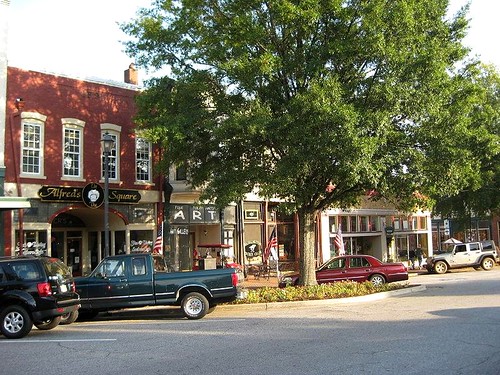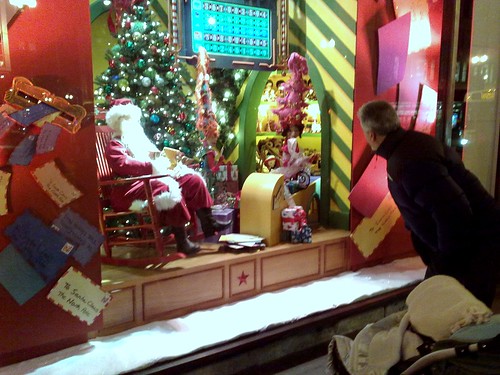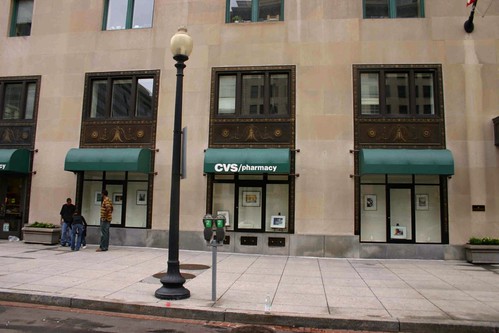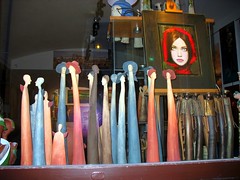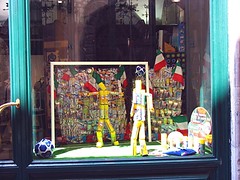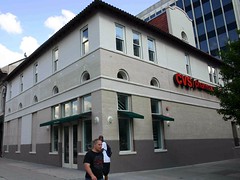Are shop windows endangered as a species?

Posted May 24, 2010 at 1:36PM
Two weeks ago, I wrote a post (‘Walkability 101-A’) drawing from Washington architect and author Roger Lewis’s succinct summary of the key elements that make a street, neighborhood or city inviting to pedestrians. One of those elements is exceptionally simple: windows, especially in commercial areas. As Roger put it, “Buildings facing public streets need lots of windows, entrance doorways and storefronts. These benefit merchants looking for customers and pedestrians looking for merchandise.” Put another way, walkers like to be amused, and we will walk more often and farther if there are interesting things for us to see. Windows also convey a sense of safety, since they add to the “eyes on the street,” to use the phrase popularized by Jane Jacobs.
Mary Means, of the Boston architecture and planning firm Goody Clancy, agrees. One of the keys to walkability, Means writes, is “[g]round level visual interest. An example: a block lined with engaging retail shops or restaurants with sidewalk tables seems a lot shorter than one lined with parking lots, vacant or windowless buildings.”
In a strikingly well-written story in Sunday’s Washington Post, however, Philip Kennicott reports that retailers, especially larger chain stores, are moving away from enticing customers with shop windows. The windows may be installed in the building in a literal sense, but they aren’t displaying much of anything and are not visually linking the inside of the establishment to the street:
“It's easy to romanticize shop windows, which, after all, are just an extension of advertising. But they were once fundamental to cities, so much so that the idle pastime of strolling the glass arcades, for philosophers such as Walter Benjamin, all but defined modern consciousness.
“Storefront windows in Washington aren't living up to this nostalgic idea. In the more urban parts of town, they still function in the old way, letting people covet goods and peer into the spectacle of shopping. But there is a new breed of window in town -- the empty, big-box, nothing-to-see-here window -- that is covered over from the moment a new retail store moves in . . .
“All over the city, where development is going forward, buildings are constructed with the old promise of Dickens's poultry shop in the architect's mind -- empty space meant to be filled with the visible bustle of people and shopping. And yet, these windows have been summarily defeated, reduced to meaningless panels of glass with nothing behind them. Look at a CVS or a chain grocery store, and you'll find these dead orifices, stopped up and neutered by panels of wall board or cloth that hide the view into the store. Even as architects struggle to give a feeling of depth and substantiality to our ephemeral commercial architecture, store owners board up these windows from the inside, and thus reveal how thin and generic the space really is.”
Part of the reason seems to be that merchants fear that windows invite vandals or burglars, apparently calculating that the risk outweighs the benefit of displaying their wares or services to potential customers. If it is not the merchant but its insurer that is making the relevant calculation, there is no benefit at all to the advertising that a window provides. (Nor is there much if any benefit if the shop is suburban and automobile-dependent.) And another part seems to be that the stores, especially the chains, want to maximize shelf space and do not want to yield what can be a shelf-lined wall to a window.
Kennicott’s excellent article continues:
“What a sad and strange reversal. In the 19th century, artists struggled to compete with and capture the vitality of the commercial streetscape, whether in novels by Balzac that dealt with the sorrows and grandeur of the new industrial economy, or a streetscape by Van Gogh showing a cafe in Arles drenched in artificial light, opposite storefronts that still beckon in the thickening twilight. Into the 20th century, storefront windows provided inspiration to museum designers, who sought to frame cultural objects with the same care as designers who worked for major department stores . . .
“A covered window is more than a concession to the hard realities of the retail economy or to the fear of crime. It is the loss of a form of consciousness -- the mutual regard of urban people for one another. It is the loss of an urban space that can't be found on any map, a place where you are on stage but not an actor, in the audience but part of the show, mixed up among I and you and we and us, a liminal space that has thrilled and terrified people since cities grew large enough to dissolve us in collective identity.”
Wow. Do yourself a favor and read the article here. (One of the neat surprises for me personally was a quote by my friend and DC Planning Chief of Staff Tanya Washington, who was my assistant here at NRDC before she went off to planning school.)
In LEED for Neighborhood Development, we tried to emphasize the importance of walkability with a streetscape that includes buildings with ground-level transparency. The first credit in the program’s “Neighborhood Planning and Development” section (NPDc1: walkable streets, pp. 48-52 of the standards) provides a menu of standards through which an applicant can earn credit. Three of those items address this issue directly:
- All ground-level retail, service, and trade uses that face a public space [must] have clear glass on at least 60% of their façades between 3 and 8 feet above grade.
- If a façade extends along a sidewalk, no more than 40% of its length or 50 feet, whichever is less, [may be] blank (without doors or windows).
- Any ground-level retail, service, or trade windows must be kept visible (unshuttered) at night.
The system doesn’t absolutely require these things, but a development that complies will score better and receive a higher rating than one that doesn’t. Since LEED-ND is new (this section was not included in the pilot program), we don’t have much experience yet in interpretation. But our intent was clearly to encourage true transparency, not windows in name only with nothing revealed behind them. We’ll see how it plays out and make changes if necessary.
Move your cursor over the images for credit information.
